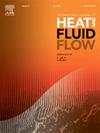Tooth surface contact temperature of spur-face gear drive in point contact considering heat flow distribution
IF 2.6
3区 工程技术
Q2 ENGINEERING, MECHANICAL
International Journal of Heat and Fluid Flow
Pub Date : 2025-01-28
DOI:10.1016/j.ijheatfluidflow.2025.109759
引用次数: 0
Abstract
Point contact and line contact are two different contacts in gear transmission. The spur-face gear drive (SFGD) is a novel gear transmission characterized by its point contact. Its meshing point trajectories are determined by calculating the tooth surface equations and meshing equations, which are established based on the shaping of the face gear and the laws of point contact during meshing. The meshing characteristics in point contact are analyzed and the load distribution ratio of SFGD is calculated according to Hertzian elastic contact theory and its multi-state meshing characteristics. Time-varying oil film parameters and friction coefficients are obtained based on the Greenwood-Williamson model as rough tooth surfaces are analyzed. A calculation method of tooth surface contact temperature (TSCT) for SFGD with point contact is developed after its tooth surface flash temperature (TSFT) is improved based on Blok flash temperature theory as oil injection lubrication is considered by integrating tribology, heat transfer, and the principles of heat flow distribution in adhered lubricant. It indicates that TSFT and TSCT are resulted in tooth surface roughness, speed, load, and contact position. A finite element model is constructed when the three-dimensional unsteady heat conduction, heat flow and boundary condition are considered to verify the theoretical calculation methods of TSFT, TSCT and bulk temperature (BT). The trend of the simulation is very close to the one of theoretical calculation. TSCT at the mesh-in and mesh-out points are higher than that at other meshing positions. TSFT at the pitch point of pinion equals to 0. TSCT at the alternating meshing position between single-pair and double-pair teeth jump, which is caused by the load variation result in the change in the number of meshing teeth pairs. TSCT can be reduced by optimizing surface roughness and input parameters. It is a theoretical foundation for the thermal behavior analysis under lubricated conditions and a significant reference for design and optimization of point contact gear drives.
求助全文
约1分钟内获得全文
求助全文
来源期刊

International Journal of Heat and Fluid Flow
工程技术-工程:机械
CiteScore
5.00
自引率
7.70%
发文量
131
审稿时长
33 days
期刊介绍:
The International Journal of Heat and Fluid Flow welcomes high-quality original contributions on experimental, computational, and physical aspects of convective heat transfer and fluid dynamics relevant to engineering or the environment, including multiphase and microscale flows.
Papers reporting the application of these disciplines to design and development, with emphasis on new technological fields, are also welcomed. Some of these new fields include microscale electronic and mechanical systems; medical and biological systems; and thermal and flow control in both the internal and external environment.
 求助内容:
求助内容: 应助结果提醒方式:
应助结果提醒方式:


